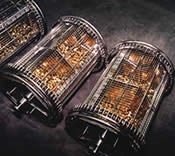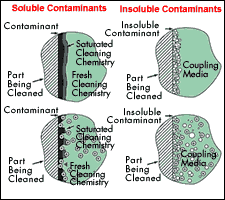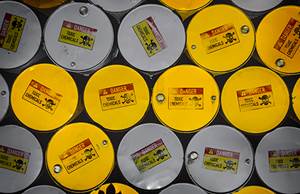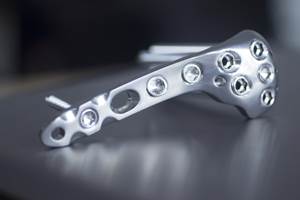A Primer On Parts Washing—Here’s How To Get Your Parts Really Clean
Cleaning is loosely defined as the process of removing unwanted contaminants or dirt from a surface. It does not alter the surface physically or chemically. A properly cleaned surface is just the same as it was prior to cleaning, except it is missing the dirt.
Cleaning is loosely defined as the process of removing unwanted contaminants or dirt from a surface. It does not alter the surface physically or chemically. A properly cleaned surface is just the same as it was prior to cleaning, except it is missing the dirt.
Contamination takes on a variety of forms, each of which requires a specific cleaning mechanism for effective removal. Furthermore, these contaminants are found on parts having various compositions and shapes, which requires that the cleaning mechanism be applied in a particular way to be effective.
Contaminants may be soluble, insoluble or mixed in nature. Soluble contaminants are suspended in a suitable and practical solvent. Solvents may include water and hydrocarbons as well as aqueous chemistries, which cause or promote the dissolution of the soluble contaminant. In short, a soluble contaminant is one that can be totally dissolved by or mixed with a solvent so that it can be rinsed or swept away.
Insoluble contaminants, such as chips and dirt, can’t be dissolved using practical cleaning chemistry. These contaminants require physical removal by force. Mixed contaminants are, as the term implies, a mixture of soluble and insoluble contamination, which may require a combination of cleaning processes and techniques to remove.
Removing Soluble Contaminants
The challenge in removing soluble contaminants is finding an appropriate solvent to dissolve them without damaging the substrate. When the substrate is relatively robust, as in the case of steel, stainless steel and many composite materials, there is little to worry about. In the case of softer metals, such as copper, brass and aluminum, carefully choosing the solvent to prevent substrate damage may be a major issue. For example, most shops use a mildly alkaline solvent that allows them to process aluminum, brass, steel and most other metals without fear of damaging the part substrate. A caustic solvent may be great for cleaning steel, but it might ruin brass or aluminum parts.
Solvent Cleaning
Today’s solvents include water-based formulations as well as traditional solvents, such as hydrocarbons. Many of the traditional solvents have been eliminated by the Montreal Protocol and may no longer be considered as practical cleaning alternatives.
The solvent cleaning process involves dissolving the soluble contaminant and diluting it until it is no longer present on the surface. In some cases, it is necessary to provide repeated applications of fresh solvent or a secondary “rinsing” solvent, such as water, to totally remove the contaminant and solvent residue. Cleaned parts are then dried to remove any remaining rinse residue, leaving a clean, dry surface.
Traditional solvents: Although the arsenal of traditional solvents is considerably smaller than it was in years past, these very effective materials remain a viable alternative in many applications where the presence of water is either intolerable or troublesome. They are also good for applications requiring extremely low surface tension to allow deep penetration into otherwise inaccessible areas.
Aqueous chemistries are the most widely used solvents. Although water has long been recognized as the “universal solvent,” the range of materials that are directly and quickly soluble in water alone is limited. The dissolution of contaminants found in the form of water-soluble solids is largely accomplished by water itself. This is often a relatively slow process, but it can be hastened by the introduction of chemical additives and mechanical energy. Water-miscible contaminants may also be diluted and ultimately cleaned away by water alone. More often than not, chemical additives are helpful in promoting this process as well. Dissolution of non-water-miscible liquid contamination requires the use of appropriate chemical additives to both separate and isolate the removed contaminant to prevent redeposition. (These additives are described in the sidebar on page 42.)
Semi-aqueous cleaning uses a solvent in conjunction with water to clean. Terpene and d-limonene are examples of solvents used in semi-aqueous cleaning. In most cases, the solvent is not inherently water-miscible but is rendered water-emulsifiable by the addition of wetting agents, emulsifiers and other chemical additives. The primary cleaning agent is the solvent.
In the cleaning process, the solvent is used either alone or partially mixed with water, depending on the contaminant being removed. The cleaning mechanism is dissolution of the contaminant by the solvent as well as by the chemical additives and water, present in the cleaning stage. Once the cleaning process is complete, the remaining chemical residue is rinsed off using pure water.
Semi-aqueous cleaning offers the benefits of solvent cleaning with the convenience of a water rinse. There are many examples of semi-aqueous cleaning, including emulsion cleaners, which are commonly a mixture of a hydrocarbon solvent and water.
Cleaning Equipment
Suitable cleaning equipment is required to implement the cleaning mechanisms previously described. The purpose of this equipment is to provide a convenient means of accomplishing the cleaning process as well as other functions, including the separation and collection of removed contamination. In addition, the cleaning equipment may enhance the cleaning mechanism through the addition of heat and mechanical energy.
The addition of some form of mechanical energy is beneficial, if not essential, to the successful application of nearly any cleaning mechanism. Without mechanical energy, the cleaning effect stagnates once the cleaning agent in immediate contact with the contaminant is saturated or consumed. Mechanical energy provides mixing to further the cleaning process as well as to displace dissolved or dislodged contaminants. Nearly all cleaning equipment uses either spray or immersion technology as the means to deliver the cleaning agent to the surface.
Spray Cleaning
Spray cleaning is probably the most widely used cleaning method in industry today. In its simplest form, spray cleaning involves delivery of a liquid cleaning agent to the surface through the use of a pump and nozzle. This same arrangement delivers mechanical energy to the cleaning site as the stream of spray impinges on the surface.
In general, spray cleaning is highly effective on any surface that can be “seen” directly by the spray. However, screw machine parts are usually batch-cleaned in baskets or totes, and while the parts on top of the pile get cleaned, they prevent the spray from reaching underlying parts.
Immersion Cleaning
Immersion cleaning, the most commonly used method for cleaning screw machine parts, involves immersing the parts in a liquid cleaning agent. Immersion alone, of course, does not inherently supply any mechanical energy. Mechanical energy is supplied by a number of auxiliary means that may be used alone or in combination.
Agitation of the cleaning solution is one way to enhance cleaning by adding mechanical energy. The goal of agitation is to deliver mechanical energy directly to the part surface where the cleaning is taking place. The selection of the appropriate means of agitation depends primarily on the configuration of the part and the degree of cleanliness required
Simple stirring of the cleaning liquid is commonly accomplished with rotary stirrers or paddles. In general, this form of agitation is gentle and does not significantly enhance cleaning in most applications unless the chemistry is very aggressive. This method is not effective in enclosed or hidden areas of a part.
Bubbled air is a gentle form of agitation with limited effect. Bubbled air has the advantage of being relatively inexpensive to initiate and easy to apply. Bubbled air is most useful in rinsing.
Turbulation, or “spray under immersion” as it is often called, involves the use of high-velocity jets of liquid created by appropriate nozzles submerged in the cleaning tank. These jets can be effective if the nozzles (eductors) can be positioned relatively close to the surface. Like spray in air, turbulation is not particularly efficient, often requiring pumps with very high horsepower to be effective in even a relatively small tank. Although not strictly a line-of-sight technology, the effectiveness of turbulation diminishes rapidly outside the direct effect of the high-velocity jet.
Ultrasonic agitation is more than just high-frequency mechanical agitation. High-frequency sound waves create small cavities (bubbles) in the cleaning liquid that collapse (implode), releasing considerable energy. Because of the nature of the phenomenon, this action is mostly concentrated at the interface between the cleaning solution and the contaminant being removed. Ultrasonic waves can penetrate thin layers of metal and propagate around corners to clean workpieces inside and out. Ultrasonic cleaning is usually not appropriate for thick buildups of contaminant.
Part agitation is another way of imparting energy to the cleaning site. Parts are literally moved up and down or side to side while immersed in the cleaning liquid to create shear forces between the liquid and the part surface. The more rapid the agitation, the more effective it becomes. Because of hydraulic “pumping” of the cleaning liquid through internal passages, part agitation can also be an effective means of cleaning inside parts with appropriate configurations.
A successful cleaning process requires careful selection of both the cleaning chemistry and equipment. While the preceding pages won’t make you an expert on parts washing, hopefully they will enable you to converse intelligently with firms that offer parts cleaning services as well as firms that sell cleaning equipment and chemicals. A firm in our area has as its slogan, “If you don’t know furs, know your furrier.” The same goes for parts washing and any other industrial process. Vendors are ready and willing to answer any questions you may have about the best methods and equipment for cleaning your parts. Some will even clean parts for you to demonstrate the benefits of their systems. There’s plenty of help out there and, now that you’re armed with some of the lingo vendors use, don’t be afraid to take advantage of it.
Related Content
Kyzen Solvents Provide Safe Parts Cleaning
The SLV901 and SLV803 solvents are formulated to maintain cleaning efficacy while providing a safe, environmentally friendly alternative to processes that use PFAS and HFCs.
Read MoreParts Cleaning Sector Shifts Energy Toward Regulatory Changes
With changes in EPA regulations regarding the use of some popular cleaning fluids, cleaning suppliers and end users are readjusting business strategies and/or cleaning processes to meet new requirements.
Read MoreKyzen Solvents Provide Ease of Cleaning for Medical Parts
The Metalnox line of solvent products are designed to improve reliability and increase the ease of cleaning in vacuum and vapor degreasing processes.
Read MoreIn-line Monitoring for Automated Immersion Cleaning Systems
Ecoclean’s Acoustic Performance Measurement (APM) system provides in-line measurement of ultrasonic frequency and power in fully automated immersion cleaning systems on a batch-by-batch basis or at defined time intervals, such as once a shift, day or week.
Read MoreRead Next
5 Aspects of PMTS I Appreciate
The three-day edition of the 2025 Precision Machining Technology Show kicks off at the start of April. I’ll be there, and here are some reasons why.
Read MoreSeeing Automated Workpiece Measurement in Real Time
User-friendly inspection software for CNC machining centers was shown at IMTS 2024 monitoring measurements between and after machining while performing SPC based on recorded measurement values.
Read MoreA Tooling Workshop Worth a Visit
Marubeni Citizen-Cincom’s tooling and accessory workshop offers a chance to learn more about ancillary devices that can boost machining efficiency and capability.
Read More
























